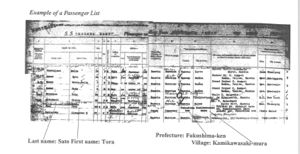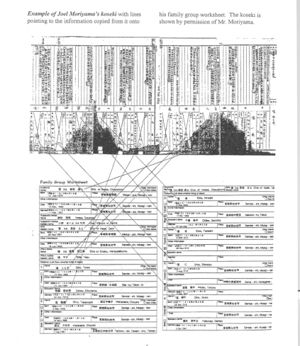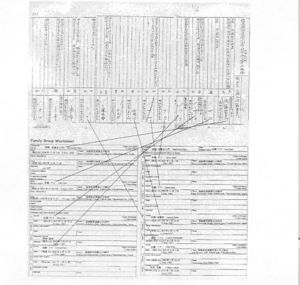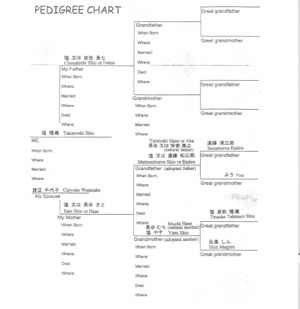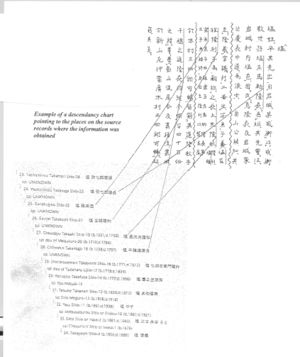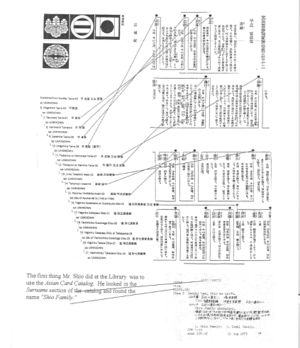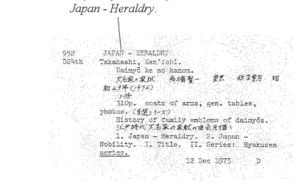Japan Research Methods
| Japan Wiki Topics | |
| Beginning Research | |
| Record Types | |
| Japan Background | |
| Local Research Resources | |
| style="float:right; margin-right:0px" |
How To Begin – Preparation
You should have already gathered as much information as possible from your home and family and filled out family group records and a pedigree chart.
Case Study of Joel Moriyama[edit | edit source]
Joel Moriyama was born in Brigham City, Utah, in the United States. His mother, Mary, was born in Garland, Utah. His mother’s father, Ushizo, was born in Fukushima-ken, Japan. He emigrated to Hawaii to work on the plantations around 1900.
He came from Hawaii to San Francisco in 1906 (family accounts say the fires were still burning when the ship landed). From there he went to Idaho and worked to earn money to send for his first wife (Tsume) in Japan, but she had died, so he asked if he could marry her younger sister, Tora. The family gave permission, and Tora arrived in Seattle from Japan in 1918.
Because his mother told him that Ushizo and Tora had a daughter who was born in 1918 in Oneida County, Idaho, Joel decided to look at the 1920 U.S. Census to find more information about the family.
They found Ushizo and Tora on the 1920 United States Census by doing the following steps:
1. They coded the name Sato, which was S – 300
2. They got the Soundex film for Idaho and found the name under “U” (for Ushizo). The Soundex gave them the County of Oneida, the Enumeration District number and the sheet and line number.
3. In the Library, they went to the drawer of Idaho', Oneida County Census films for 1920.'''
4. On the Census, they found the family names, the year of emigration, and other information.
Note: An example of the 1920 U.S. Census where Ushizo’s family is listed follows.
5. On the back of Ushizo’s Family Group Worksheet, they recorded the sources they had used under “Notes and Sources.”
The next source of information Joel wanted to get was the Japanese Household register, or koseki. This record is available to direct descendants of people in Japan, and is the best source of family information for Japanese research. To obtain it, you need to know the name of head of the house and the prefecture (ken) and town, city, or village (mura) where the person came from.
Joel was not sure of the village name, so he decided to look for the passenger list of the ship Tora came on. He knew she came in 1918 from Japan to San Francisco. He decided to look in the FamilySearch Catalog to see if any immigration records for that time and place were listed.
In the catalog, Joel found the listing under – United States – Emigration and Immigration
Joel got the film and put it on the microfilm reader. After scrolling through the film, he came upon a passenger list with Tora’s name.
Note: An example of the passenger list that has Tora’s name on it follows. The prefecture of Fukishima-ken and the village of Kamikawasaki-mura is also listed.
The next piece of information Joel needed to order was the kosekiwith the name of the head of the house. This is usually a grandfather. He learned from his mother, Mary, that Tora’s father’s name was Sakiemon Sato. With this information, Joel could now order the koseki from Japan.
Note: For instructions on ordering the koseki and a blank order form to copy for your use, see the article "Census" in this outline.
Joel went to the Family History Library in Salt lake City to use the address book for ordering the koseki, and found that it was in Japanese, so he got a bilingual staff member from the Library to help him. This same person helped him fill out the order form, which he mailed to Japan.
When he received the koseki records, Joel could not read them because they were in Japanese, so he got a friend to help him translate the information and transfer it from the kosekirecords to his family group worksheets and pedigree chart.
The koseki shows that Ushizo and Tora were married by proxy in Japan July 10, 1914.
The following example of the koseki Joel received shows lines pointing to the information he copied from it onto his family group worksheet.
From this point on, the same procedure is used for all Japanese research. For an example of how another person did his research, see the case study of Mr. Shio.
Case Study of Mr. Shio[edit | edit source]
In this case study, the person who does the research must already read Japanese, or have someone who does read Japanese helping him.
Mr. Shio already had his grandfather’s kosekirecords. He filled out a pedigree chart and a family group worksheet, using the information from the koseki.
On the pedigree, we see that Mr. Shio’s grandmother was adopted by the Shio family.
Example of Shio pedigree
Mr. Shio also had in his possession a family genealogy that extends back many generations. He wanted to verify the ancestors’ information by using records that were available at the Family History Library.
Note: Not all families have a genealogy of this kind. Se the article Records To Use for other suggestions.
He wrote the film number and viewed the microfilm at the Library.
He used some information from this source to verify some of his family records.
To prove that the Shio surname was part of the Iwaki family, Mr. Shio used the book Dimiyo ke no Kamon. This is a useful reference. It contains an index. He looked under “Iwaki” and “Taira” family. The example above shows several ancestors’ names that came from the book. This book is listed in the Asian Card Catalog and is available at the Family History Library. It is from the Place Search heading.
By looking at the family crests at the top of the example, we see that the Iwaki family has four different family crests. The one at the far right is the Shio family crest. It is one of the Iwaki'''''''family crests as well.
If your case is not the same as Mr. Shio’s, you can still try to find more information by using the additional records listed in the article Records To Use.
Case Study of Kin-itsu Hirata
[edit | edit source]
Dr. Kin-itsu Hirata presented a lecture titled "The Search for My Japanese Roots: Using Buddhist and Local Sources," at the World Conference on Records held in Salt Lake City, Utah in 1980. In his syllabus, he identifies key sources for reconstructing a Japanese family tree, their reliability, and methodologies for locating these records and extracting genealogical information from them. Dr. Hirata's syllabus is available at the Family History Library [1]
A wiki article describing an online collection is found at: Japan Village Records - FamilySearch Historical Records



.jpg/250px-Japan_page3(1).jpg)
.jpg/300px-Japan_page3(2).jpg)
.jpg/300px-Japan_page4(1).jpg)
.jpg/300px-Japan_page4(2).jpg)
